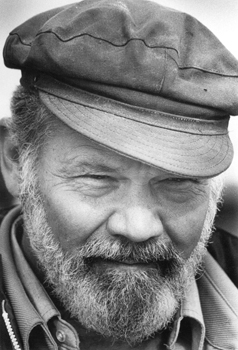Next Thursday Homer will be the host of the Governor’s Picnic when Alaska’s 10th governor, Sean Parnell visits, so it seems appropriate this Sunday that we pause and remember Alaska’s fourth governor, Jay Hammond, who served from 1974 to 1982. The Alaska Legislature in its wisdom designated July 21 Jay Hammond Day. In signing the proclamation, Parnell said he encouraged “Alaskans to remember his service to our state and honor his memory on his birthday.”
Hammond didn’t just break the mold for what an Alaska governor should be. He ground the mold into dust and scattered it to the winds. There hasn’t been a governor like him since. Bush rat, pilot, homesteader, commercial fisherman and poet, other governors might have sampled his range of talents but none have achieved the full buffet.
In Hammond’s years as governor, and his subsequent public service afterward, Hammond advocated a basic political principle: the rich resources of Alaska should be managed to benefit Alaskans while protecting the environment.
“Jay Hammond was clear thinking and prophetic to a remarkable degree. His ideas for achieving the maximum benefit for the people were original and well informed,” wrote Larry Smith in the introduction to “Exporting the Alaska Model, Adapting the Permanent Fund for Reform Around the World.”
Hammond’s philosophy has been best expressed in the four questions he said should be asked about any resource development project: Is it environmentally sound? Can it pay its own way? Do the majority of Alaskans desire the project? And will it contribute to the Permanent Fund?
In Kachemak Bay, that philosophy can be seen in Hammond’s advocacy of buying back oil and gas leases sold during Gov. William Egan’s administration. As retired biologist Loren Flagg noted, Egan had pushed through a lease sale without any consideration of its environmental impacts — or even a public hearing. After Hammond beat Egan in 1974, he pledged to buy back the leases because of the danger to the bay’s rich fisheries and the lack of public debate.
The buyback also was one of Hammond’s legacies here, for it resulted in the creation of the Kachemak Bay Critical Habitat Area and a strong commercial fishing, tourism and arts economy.
When the final oil and gas lease was repurchased in 1977, Hammond called it a turning point in Alaska history.
“It represents the end of an era when we sold our oil resources without any real reflection on the impact of the sale,” Hammond said.
Elected first as a legislator from Naknek, running as an independent, he started his career when the Democratic Party dominated the Legislature. Later running as a Republican, he butted heads with Wally Hickel, his opponent in the primary. Alaska historian Michael Carey called Hammond “a quirky Republican who, while fiscally and socially conservative, had little in common with GOP movers and shakers in Anchorage and Fairbanks.”
Bipartisan by necessity, Hammond crafted collaborations between moderate Republicans, liberal Democrats, environmentalists and the Bush caucus. Out of that compromise came such things as the Alaska Permanent Fund and the dividend program, one of Hammond’s legacies. Hammond would say he was not a politician, but as Carey noted, he was “a politician down to his very bones.” That he could deny being so and not be thought of one shows how good he became in the art of steering disagreeable parties to do well for the common good.
Politics could use a few more Jay Hammonds, a few more elected officials who follow his principles. On his birthday this Sunday, when he would have been 91, it’s worth contemplating his grand life and how it can inspire us to be better Alaskans.


